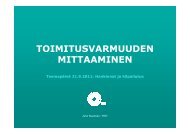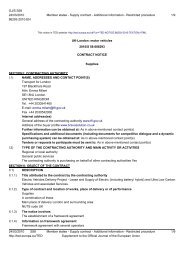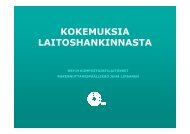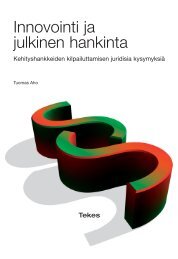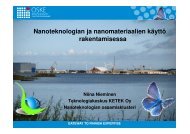Life cycle costing (LCC) as a contribution to sustainable construction ...
Life cycle costing (LCC) as a contribution to sustainable construction ...
Life cycle costing (LCC) as a contribution to sustainable construction ...
Create successful ePaper yourself
Turn your PDF publications into a flip-book with our unique Google optimized e-Paper software.
Towards a common European methodology for <strong>Life</strong> Cycle Costing (<strong>LCC</strong>) – Guidance Document<br />
15<br />
tender’ (EMAT). The Common Methodology is particularly relevant <strong>to</strong> EMAT <strong>as</strong> this<br />
award b<strong>as</strong>is permits life <strong>cycle</strong> costs <strong>to</strong> be taken in<strong>to</strong> consideration.<br />
4.3.2 Specifications and sustainability issues<br />
The ability <strong>to</strong> use output or performance specifications supports competition and innovation<br />
in procurement. It allows procurers <strong>to</strong> stipulate requirements in respect of life <strong>cycle</strong> costs<br />
and sustainability/environmental considerations in particular, whilst leaving suppliers the<br />
freedom <strong>to</strong> propose how these will be delivered.<br />
Section 4.4 below describes how the Common Methodology can be used <strong>to</strong> help take<br />
account of and improve the sustainability of <strong>construction</strong> and building.<br />
4.3.3 Contract award and EMAT (economically most advantageous tender)<br />
Public works contracts may be awarded on the b<strong>as</strong>is of lowest price or EMAT. Note that<br />
these criteria are concerned with the contract Award process. Contract Award considers the<br />
proposals for the specific contract, and is quite separate from the selection or prequalification<br />
process which, under the Works Directive, considers the status and p<strong>as</strong>t<br />
performance of tenderers. The award of works contracts on an EMAT b<strong>as</strong>is provides an<br />
excellent opportunity for procurers <strong>to</strong> take account of life <strong>cycle</strong> costs by using the Common<br />
Methodology.<br />
The EMAT procedure w<strong>as</strong> established because of concern over abnormally low tenders<br />
(ALTs) received using the lowest price option. Recent work by a T<strong>as</strong>k Group1, under the<br />
auspices of the DG Enterprise Working Group on Abnormally Low Tenders, made a series<br />
of recommendations on the award of contracts on the b<strong>as</strong>is of the economically most<br />
advantageous tender. While these recommendations provide useful pointers for how <strong>LCC</strong><br />
might be taken account of in an EMAT process, they have not generally been taken forward<br />
and currently there is no systematic guidance or methodology that is commonly in use across<br />
the EU on the evaluation of EMAT. It is important <strong>to</strong> consider briefly the main elements of<br />
an EMAT process <strong>to</strong> understand how <strong>LCC</strong> may be used effectively within it. EMAT should<br />
provide for a fair, transparent and accountable method for evaluating tender submissions,<br />
including:<br />
The award criteria<br />
The award mechanism against which tenders are evaluated<br />
The award procedure<br />
Award criteria provide the principal opportunity <strong>to</strong> include life <strong>cycle</strong> costs in the Award<br />
process. This may be done by, for example, including quality and life <strong>cycle</strong> cost<br />
requirements <strong>as</strong> prominent criteria in the Award process.<br />
The Common Methodology provides a sound and robust b<strong>as</strong>is for estimating life <strong>cycle</strong> costs<br />
and fully supports the EMAT process. Costs <strong>as</strong>sessed using the Methodology will be<br />
consistent and comparable, provided of course the definitions and calculation processes<br />
contained in the Methodology are clearly and consistently followed. Costs may, for e<strong>as</strong>e of<br />
comparison, be broken down in accordance with the Methodology <strong>to</strong> provide a means of<br />
1 Report and Recommendations of the EMAT T<strong>as</strong>k Group: A methodology that permits contract award <strong>to</strong> the<br />
Economically Most Advantageous Tender (Revised 15 August 2003)<br />
Davis Langdon Management Consulting May 2007



